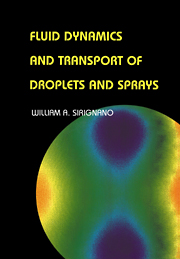Book contents
- Frontmatter
- Contents
- Preface
- Nomenclature
- 1 Introduction
- 2 Theory of Isolated Droplet Vaporization, Heating, and Acceleration
- 3 Multicomponent Liquid Droplets
- 4 Droplet Arrays and Groups
- 5 Spray Equations
- 6 Computational Issues
- 7 Spray Applications
- 8 Droplet Interactions with Turbulence and Vortical Structures
- 9 Droplet Behavior at Near-Critical, Transcritical, and Supercritical Conditions
- Appendix A The Field Equations
- Appendix B Droplet-Model Summary
- Appendix C Guiding Principles for Two-Continua Formulation
- References
- Subject Index
Appendix B - Droplet-Model Summary
Published online by Cambridge University Press: 13 October 2009
- Frontmatter
- Contents
- Preface
- Nomenclature
- 1 Introduction
- 2 Theory of Isolated Droplet Vaporization, Heating, and Acceleration
- 3 Multicomponent Liquid Droplets
- 4 Droplet Arrays and Groups
- 5 Spray Equations
- 6 Computational Issues
- 7 Spray Applications
- 8 Droplet Interactions with Turbulence and Vortical Structures
- 9 Droplet Behavior at Near-Critical, Transcritical, and Supercritical Conditions
- Appendix A The Field Equations
- Appendix B Droplet-Model Summary
- Appendix C Guiding Principles for Two-Continua Formulation
- References
- Subject Index
Summary
The purpose of this appendix is to summarize the algorithms available to predict in an approximate but reasonable manner droplet heating, vaporization, and trajectory in a userfriendly manner. We consider single-component and multicomponent droplets, isolated droplets and droplets interacting with droplets, and stagnant and moving droplets. We do not consider turbulence or critical thermodynamic conditions in this section. The underlying theories are detailed in Chapters 2 and 3.
The description of the quasi-steady gas film can be summarized by the use of drag coefficient CD, lift coefficient CL, Nusselt number Nu, Sherwood number Sh, and a nondimensional vaporization rate ṁ/4πρDR. These quantities can be prescribed as functions of the transfer number B, the droplet Reynolds number Re, and a nondimensional spacing between neighboring droplets.
The vaporization rate and the other parameters will depend (through the parameters B and Re) on the ambient conditions outside the gas film and on the droplet-surface conditions. To determine the vaporization rate, Nusselt number, and Sherwood number quantitatively, we must simultaneously solve for the temperature and composition at the droplet surface. Typically the solution of diffusion equations for heat and mass in the droplet interior must be solved. These solutions of the diffusion equations require some determination of the internal droplet-velocity field.
For the single-component, isolated droplet, there are three approximate models that have been considered in Chapter 2. Table B.I presents the summary for the spherically symmetric case; Tables B.2 and B.3 present the vortex model and the effectiveconductivity model, respectively.
- Type
- Chapter
- Information
- Fluid Dynamics and Transport of Droplets and Sprays , pp. 278 - 282Publisher: Cambridge University PressPrint publication year: 1999



